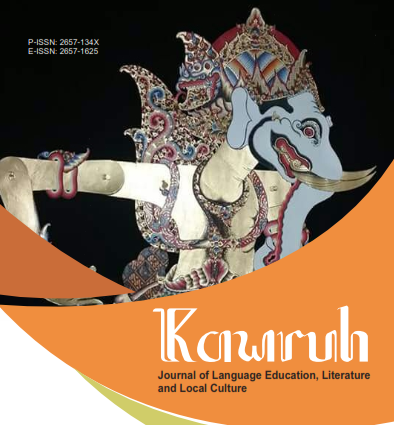Aesthetics Of Wayang Symbols On The Ceiling Of Graha Sahid Surakarta Building: Cultural Influence In Interior Design
DOI:
https://doi.org/10.32585/kawruh.v6i2.5065Abstract
This research explores the use of wayang symbols in the ceiling design of Graha Sahid Surakarta and its impact on cultural aesthetics in interior design. Wayang as a traditional Indonesian art has symbols with deep cultural and philosophical meanings. The purpose of this study is to analyze how wayang symbols are applied in ceiling design to create a balance between cultural heritage and modern architecture. The research methodology uses qualitative which includes literature study, observation and interviews with building designers and building users. The findings of this study show that the application of wayang symbols on the ceiling of Graha Sahid Surakarta not only enhances the aesthetic value but also strengthens the cultural identity of the building. The integration of wayang motifs in the ceiling design shows how cultural elements can be combined with contemporary aesthetics to produce a unique and meaningful space. This research highlights the importance of understanding and applying cultural symbols in interior design to enrich the experience of space and strengthen cultural connections in a modern context.
Downloads
References
Al Mohgny, F., & Raidi, S. (2024). Harmoni Estetika melalui Penerapan Material dalam Redesain Lounge Hotel Sahid Raya Yogyakarta. Prosiding (SIAR) Seminar Ilmiah Arsitektur , 436–444.
Darmayanti, T. E., Drajat, R. P., & Isfiaty, T. (2022). Membaca Visual Wayang Beber Sebagai Ide Perancangan Ruang. Visual Heritage: Jurnal Kreasi Seni Dan Budaya, 4(3), 309–317. https://doi.org/10.30998/vh.v4i3.5904.
Fatmawati, L. (2020). Ajaran Hastabrata Dalam Pentas Wayang Kulit Lakon Wahyu Makutharama Sajian Ki Sunu Wijoyo Carito Dan Rencana Pelaksanaan Pembelajarannya Di SMA Kelas X. UNWIDHA Repository, 1–87.
Istikomah, Aris Aryanto, & Eko Santosa. (2024). Kajian Folklor Tradisi Bersih Desa Di Desa Loano Kecamatan Loano Kabupaten Purworejo. Kawruh: Journal of Language Education, Literature and Local Culture, 6(1), 18–27. https://doi.org/10.32585/kawruh.v6i1.4519.
Khalisha, A., & Ischak, M. (2023). Penerapan Ornamen Lokal Pada Desain Gedung Wayang Orang Sriwedari Surakarta Dengan Pendekatan Arsitektur Neo Vernakular. AGORA:Jurnal Penelitian Dan Karya Ilmiah Arsitektur Usakti, 20(2), 123–133. https://doi.org/10.25105/agora.v20i2.14281.
Margolin, V. (2015). World History of Design Volume 2. Bloomsbury Publishing.
Mulyati, M. I., & Sudiana, I. K. (2022). Lukisan Wayang Kamasan Sebagai Salah Satu Elemen Dekorasi Interior untuk Memberi Nuansa Bali yang Unik. Journal on Education, 5(1), 799–807. https://doi.org/10.31004/joe.v5i1.686.
Nafisha, A. A. (2024). Kajian Ekspresi Budaya Jawa Padaruang Publik: Studi Kasus Taman Indonesia Kayasemarang. SINEKTIKA: Jurnal Arisitektur, 21(2), 11–21.
Rendell, J. (2006). Art and Architecture: A Place Between. IB Tauris.
Rina, R. C., Adriati, I., & Irfansyah. (2017). Keanekaragaman Visualisasi Tokoh Arjuna dalam Media. Seminar Nasional Seni Dan Desain, 44–49.
Seftianingsih, D. K., & Rifai, D. M. (2024). The Influence of Interior Element Color on The Activities of Classroom Users in Sps Mutiara Bunda. Pendhapa, 15(1), 49–56.
Syam, N. (2005). Islam Pesisir (A. Rozaki, Ed.; 1st ed.). PT LKiS Pelangi Aksara Yogyakarta.
Widayat, R. (2010). Estetika Jawa Dalam Konteks Desain Interior Dan Arsitektur. Prosiding Seminar Nasional, 97–107.
Woodward, M. R., & Salim, H. (2004). Islam Jawa; Kesalehan Normatif Versus Kebatinan (Amirudin & Nuruddin, Eds.). LKiS Yogyakarta.
Museum Basoeki Abdullah. (2016, 18 Januari). Bima (Werkudara). Diakses pada 25 Maret, dari https://museum.kemdikbud.go.id/koleksi/profile/bima+%28werkudara%29_22997.
Downloads
Published
How to Cite
Issue
Section
License
Copyright (c) 2024 Dina Kristiana Seftianingsih, Indy Rafia, Dian Muhammad Rifai, Dea Syahnas Paradita

This work is licensed under a Creative Commons Attribution-ShareAlike 4.0 International License.
Authors who publish with the Kawruh: Journal of Language Education, Literature and Local Culture agree to the following terms:
- Authors retain copyright and grant the journal the right of first publication with the work simultaneously licensed under a Creative Commons Attribution License (CC BY-SA 4.0) that allows others to share the work with an acknowledgment of the work's authorship and initial publication in this journal.
- Authors are able to enter into separate, additional contractual arrangements for the non-exclusive distribution of the journal's published version of the work (e.g., post it to an institutional repository or publish it in a book), with an acknowledgment of its initial publication in this journal.
- Authors are permitted and encouraged to post their work online (e.g., in institutional repositories or on their website) prior to and during the submission process, as it can lead to productive exchanges, as well as earlier and greater citation of published work.

